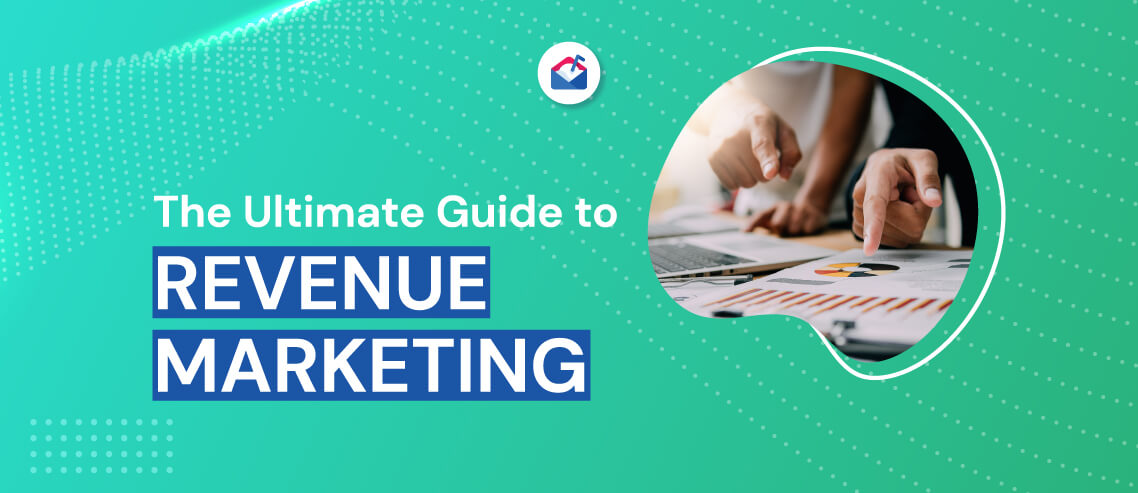The Ultimate Guide to Revenue Marketing

Contents
Traditional business processes and operations are evolving. In fact, many of them are already completely obsolete. As digital transformation continues to change the way we do things and market forces keep throwing us curveballs, aligning teams toward a common objective is critical to success.
Nowhere is this more important than in sales and marketing. Gone are the days when sales and marketing could sit in siloed teams, only interacting when one needed something from the other. Today, sales and marketing must work closely together to achieve the company’s revenue goals.
That’s where revenue marketing comes in. This philosophy utilizes an objective, revenue-driven approach at all touchpoints within the sales funnel.
What is Revenue Marketing?
Revenue marketing is an approach to the sales funnel that involves aligning the marketing and sales teams toward a shared objective and ensuring they support each other in the achievement of that common goal. The goal, of course, is driving revenue.
At its core, revenue marketing increases revenue by establishing a closed loop of data and feedback between sales and marketing. It ensures that the responsibility to drive revenue is evenly shared and shouldered by both teams.
When you have a fully operational revenue marketing model in play, your strategy, operations, technology, and growth philosophy will enable your marketing team to:
- Provide purchase-ready leads to the sales team
- Accelerate the path through the sales funnel from awareness to purchase
- Measure performance through predictable and relevant KPIs directly tied to revenue generation
The proof is in the numbers: A report by MarketingProfs found that aligning sales and marketing can improve your win rate by 38%.
The Evolution of the Sales Funnel
Up until very recently, the role of marketing was very clear: Generate brand awareness and provide lots of top-of-funnel leads for sales. After that, it was up to sales to lead the way down the rest of the funnel and close the deal.
But the purchasing journey, especially in B2B sales, is becoming far more complex. B2B buyers are taking more self-directed paths to purchase. When the sales funnel becomes less of a funnel and more of a winding buying journey, the role of marketing must shift to support the entire buying cycle.
The marketing funnel evolution comprises four main stages: traditional marketing, lead generation, demand generation, and revenue marketing.
1. Traditional marketing
In traditional marketing, there is minimal focus on revenue impact. If any metrics are tracked, they are tied to actions rather than bottom-line results. Click-through rates and website traffic might tell you how well put together your marketing materials are, but they provide little to no insight on marketing’s impact on the bottom line.
2. Lead generation
In a lead generation model, marketing’s core job is to provide as many leads to the sales team as possible. However, lead generation tactics are still a relatively immature approach to revenue growth because:
- There is little focus on lead quality over quantity
- The responsibility to close deals from the top of the funnel downward still lies solely with sales
- Marketing may continue to bring in the same leads multiple times, even if the opportunity has already been disqualified
- Sales teams waste time chasing and disqualifying high volumes of bad leads
3. Demand generation
Organizations at the demand generation stage take a huge step forward toward the revenue marketing model.
Marketing teams no longer simply place high volumes of leads at the top of the funnel for sales. They create marketing collateral for all stages of the sales funnel and support pipeline acceleration.
This includes:
- Marketing strategies that are laser-focused on generating high-quality leads from well-defined target audiences
- Marketing automation systems in place that are integrated with the CRM
Metrics on revenue also begin to take precedence over activity-based marketing KPIs, including the amount of marketing qualified leads handed over to sales, how many of those progress to opportunities, and, ultimately, closed sales.
4. Revenue marketing
This takes all the activities, processes, and automation established in the demand generation phase and ensures that revenue generation is repeatable and scalable.
When revenue marketing is established, marketing can demonstrate their direct contribution to revenue generation. Even more importantly, they can forecast and predict their contribution to revenue in the future by tightly aligning their metrics with sales for the full sales funnel.
Benefits of a revenue marketing strategy
There are three key ways in which revenue marketing brings value to everyone involved.
1. Sales benefits
With revenue marketing, the sales team has everything they need (context and collateral) to turn prospects from opportunities into won revenue in much less time.
2. Marketing benefits
In turn, the continuous flow of revenue-based data and metrics between marketing and sales ensures that the marketing team can hone in on highly valuable lead generation activities. They can shape messaging and create campaigns designed to maximize the ROI of marketing spend.
3. Customer/prospect benefits
Marketers can now craft drip campaigns, ads, and content in an informative, useful, and holistic way for prospects. At every stage in the funnel, prospects in a revenue marketing funnel receive valuable and relevant communication to ease their path to purchase.
How to get started with a revenue marketing strategy
Getting started with a revenue marketing strategy means clearly defining your lead generation and demand generation processes and tactics.
1. Get a tight grasp on your target audience
Map out the path to purchase of your customers, but make it as detailed as possible. Understand exactly who you’re targeting, how they prefer to research and buy, and where is most optimal to influence them throughout the cycle.
2. Add revenue accountability to marketing metrics
More traditional marketing KPIs can still be used to inform strategy and tactics within the marketing team’s activities, i.e., which subject lines are working best, how you can improve an ad to generate more clicks, and so on.
But the performance metrics of marketing should be tied directly to sales and to bottom-line revenue impact. By combining sales and marketing metrics and objectives, you’ll be able to pinpoint marketing’s revenue generation performance.
3. Adopt marketing automation and CRM integrations
Closed-loop data and analytics between sales and marketing are essential components of revenue marketing. This means that any movement by a prospect in the funnel should feed back directly to marketing’s data and analytics to better inform their strategies and tactics. It also informs marketing on when to influence prospects with a new touchpoint to help nurture the opportunity throughout the full sales funnel.
4. Actively engage in a culture shift
If you’re facing the daunting task of moving your organization from a traditional or lead generation philosophy toward revenue marketing, don’t forget to pay attention to shifting culture and attitudes in this direction too. It can take some time and commitment to ensure all team members at all levels are committed to a new way of doing things.
5. Establish closed-loop sales and marketing data
Aside from a common strategy and goals, it’s important to centralize sales and marketing data so that any automation and background processes are also shared. From your CRM to your marketing automation and workflow tools, marketing needs real-time data from sales to achieve a true revenue marketing strategy.
Automated prospecting for revenue marketing teams
Automated outreach that is fully optimized to accelerate the sales funnel is a core component of revenue marketing. With Mailshake, you can convert cold prospects into warm leads, make more connections, and scale your email outreach and sequences all from one dashboard. Book a demo to learn more about Mailshake’s outreach automation or sign up for our newsletter for all the latest sales and marketing resources.





